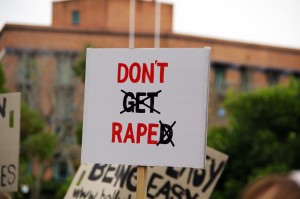A few weeks ago, the Rape, Abuse and Incest National Network (RAINN) wrote to the Department of Justice’s White House Task Force to Protect Students from Sexual Assault regarding the epidemic of rape on college campuses. RAINN is generally considered to be an authority on these issues and has been praised for its work in advancing victim and survivor care.
However, the memorandum sent to the White House on behalf of RAINN was not in line with what I, and many others, expected from it. I would like to outline what I found most problematic with the report.
Rape culture is severely undermined as a major actor in increased rates of rape.
For those of you unfamiliar with rape culture, take a look at this. Rape culture is, essentially, the propagation of the idea that victims of rape (whether they be men or women) are at fault because of what they were wearing, drinking, doing or saying. It has infiltrated our society, making sentiments such as “she was asking for it” commonplace and acceptable. Rape culture undermines the safety and security of women and men everywhere and, in doing so, dominates our society. It relates to tendencies in which men are praised for sexual conquests, while women are shamed for immoral decisions. RAINN ignores the effect of rape culture on college campuses and instead condemns peoples’ highlighting of the factors that seem to make rape more likely, such as the hypermasculine cultures of fraternities or athletic teams.
I by no means wish to say that all males in that demographic are rapists. Such generalizations are harmful and simply not based in fact. However, I don’t think we should ignore the sociological and psychological research that shows that fraternity men are significantly more likely to participate in the perpetuation of classic gender norms through hypermasculinity and sexual callousness, both of which predict coercive sexual behavior. Fraternity members also “endorse rape supportive attitudes at a significantly higher rate than nonfraternity members.” Furthermore, all-male institutions and organizations have been found to cultivate sexual aggression and violence towards women, since these traits are considered masculine and nonconformity is seen as a sexual failure of sorts.

The memo seems to indicate that prior to entering college, students are constantly exposed to anti-rape messages via parents, religious leaders and the media.
I cannot speak to the truth of this statement in regard to parents and religious leaders, but I can attest to the fact that the media, for the most part, supports rape culture in that it constantly depicts women as sexual objects. It’s simple – the media disproportionately values women for their looks. Whether it is exclusively female Oscar nominees getting questioned on their outfits or the plethora of publications dedicated solely to enhancing the female aesthetic, the message is clear: women are trophies to be desired. Political writer and analyst Zerlina Maxwell agrees.
Additionally, the media should also be held responsible for reducing blame on behalf of the perpetrator. Let’s bring ourselves back to the Steubenville case. Two teenage males sexually assaulted an unconscious female, and yet CNN reporters expressed sympathy for the effect this would have on the boys’ promising futures; the victim received death threats and experienced harassment after her identity was revealed. We should be using all available platforms to denounce rape and sexual violence. Instead we have instances like Steubenville. We immensely diminish the severity of rape by telling young men and women that convicted rapists still deserve our consideration and kindness before their victims do.
Its advice for preventing sexual violence on college campuses contains messages of the “don’t get raped” (rather than “don’t rape”) variety.
RAINN even says that we should not aim rape prevention strategies at potential perpetrators, while also claiming that it doesn’t advocate victim blaming. To me, these are very much the same, and not as mutually exclusive as RAINN might suggest. We should not live in a world where women carry pepper spray in their pockets and walk home holding keys between their fingers because the threat of rape is so familiar.
It isn’t a world I want to live in, and while I do take preventative measures, I shouldn’t have to. We should instead be making every effort to change the status quo of normalized rape culture. The phenomenon of victim-blaming particularly fascinates me, as it is exclusive to rape. Have you ever heard any of murder, theft or arson victims being blamed? Probably not. Society seems to understand that an outfit cannot make someone kill you. In fact, it sounds ridiculous to even make that claim. But society cannot seem to grasp the concept that rapists decide to rape – it is not because of an outfit or a drink. It is always an active decision to rape.
The biggest problem with the report is that RAINN holds a position as a leader in the anti-rape arena. When an organization at the forefront of this fight ignores rape culture, the whole movement is undermined. That is exactly what has happened here.

Hi Charlie – thank you for checking out the article. I appreciate your feedback. On page 3 of the report you will find the following “Perhaps counter-intuitively, we recommend not focusing prevention messaging towards potential perpetrators…” I agree with what you said in that RAINN has done some great work and made many positive changes. However, I do think it is important to consider the possible negative consequences from the advice given in the memo.
“RAINN even says that we should not aim rape prevention strategies at potential perpetrators”
I really liked this article all the way up until you said that. Please do not lie about an organization that has made so many positive strides.
http://www.rainn.org/news-room/rainn-urges-white-house-task-force-to-overhaul-colleges-treatment-of-rape